Electronic Circuit Inspection Procedure
ELECTRONIC CIRCUIT INSPECTION PROCEDURE
BASIC INSPECTION
(a) WHEN MEASURING RESISTANCE OF ELECTRONIC PARTS
(1)
Unless otherwise stated, all resistance measurements are standard
values measured at an ambient temperature of 20°C (68°F). Resistance
measurements may be inaccurate if measured at high temperatures, i.e.
immediately after the vehicle has been running. Measurements should be
made after the engine has cooled down.
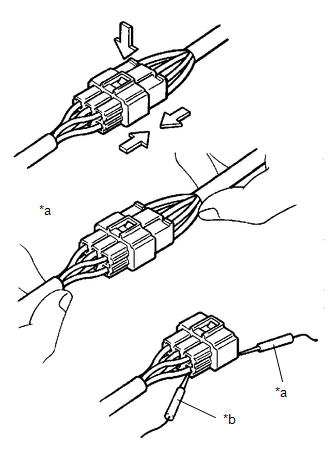
(b) HANDLING CONNECTORS
(1)
When disconnecting a connector, first squeeze the mating connector
housing halves tightly together to release the lock, and then press the
lock claw and separate the connector.
(2) When disconnecting a connector, do not pull on the harnesses. Grasp the connector directly and separate it.
(3) Before connecting a connector, check that there are no deformations, damage, looseness or missing terminals.
(4) When connecting a connector, press firmly until it locks with a "click" sound.
(5)
If checking a connector with an electrical tester, check the connector
from the backside (harness side) using a mini test lead.
NOTICE:
- As a waterproof connector cannot be checked from the backside, check it by connecting a sub-harness.
- Do not damage the terminals by moving the inserted tester probe (mini test lead)
(c) CHECKING CONNECTORS
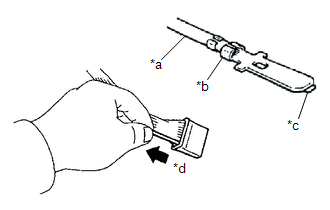
|
*a | Core Wire |
|
*b | Looseness of Crimping |
|
*c | Terminal Deformation |
|
*d | Pull Lightly |
(1) Checking when a connector is connected: Squeeze the connectors together to confirm that they are fully connected and locked.
(2)
Checking when a connector is disconnected: Check by pulling the wire
harness lightly from the backside of the connector. Look for unlatched
terminals, missing terminals, loose crimps or broken conductor wires.
Visually check for corrosion, metallic or foreign matter and water, and
bent, rusted, overheated, contaminated or deformed terminals.
(3)
Checking the contact pressure of the terminal: Prepare a spare male
terminal. Insert it into a female terminal, and check for ample tension
when inserting and after full engagement.
NOTICE:
When testing a gold-plated female terminal, always use a gold-plated male terminal.
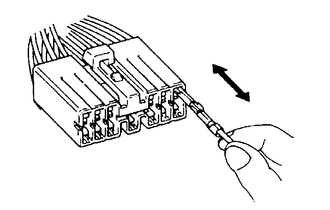
(d) CONNECTOR TERMINAL REPAIR METHOD
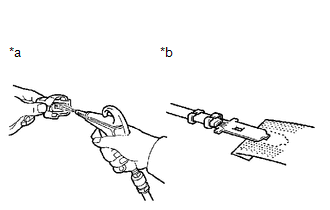
(1)
If there is any foreign matter on the terminal, clean the contact point
with compressed air or a cloth. Never rub the contact point using
sandpaper as the plating may come off.
(2) If there
is abnormal contact pressure, replace the female terminal. If the male
terminal is gold-plated (gold color), use a gold-plated female terminal;
if it is silver-plated (silver color), use a silver-plated female
terminal.
(3) Damaged, deformed or corroded
terminals should be replaced. If the terminal does not lock into the
housing, the housing may have to be replaced.
(e) WIRE HARNESS HANDLING
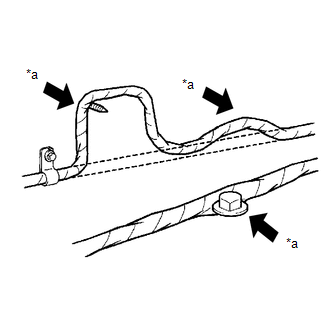
(1) If removing a wire harness, check the wiring and clamps before proceeding so that it can be restored in the same way.
(2) Never twist, pull or slacken the wire harness more than necessary.
(3)
The wire harness should never come into contact with any high
temperature, rotating, moving, vibrating or sharp-edged parts. Avoid
contact with panel edges, screw tips and other sharp items.
(4) When installing parts, never pinch the wire harness.
(5)
Never cut or break the cover of the wire harness. If it is cut or
broken, repair it with insulating tape or replace the wire harness.
CHECK FOR OPEN CIRCUIT
(a) For an open circuit in the wire harness in Fig. 1, measure the resistance and voltage as follows:
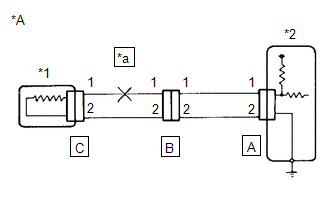
|
*A | Fig. 1 |
|
*1 | SENSOR |
|
*2 | ECU |
|
*a | OPEN |
(b) Check the resistance.
(1) Disconnect connectors A and C, and measure the resistance between the terminals of the connectors.
Standard Resistance (Fig. 2):
|
Tester Connection | Condition |
Specified Condition |
|
Connector A terminal 1 - Connector C terminal 1 |
Always | 10 kΩ or higher |
|
Connector A terminal 2 - Connector C terminal 2 |
Always | Below 1 Ω |
HINT:
Measure the resistance while lightly shaking the wire harness vertically and horizontally.
- If the results match the values specified above, an open circuit exists
between terminal 1 of connector A and terminal 1 of connector C.
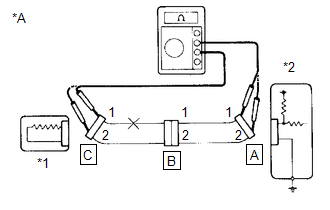
|
*A | Fig. 2 |
|
*1 | SENSOR |
|
*2 | ECU |
(2) Disconnect connector B and measure the resistance between the terminals of the connectors.
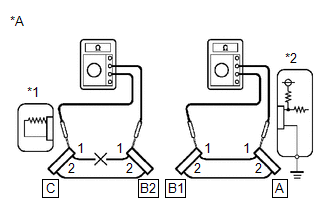
|
*A | Fig. 3 |
|
*1 | SENSOR |
|
*2 | ECU |
Standard Resistance (Fig. 3):
|
Tester Connection | Condition |
Specified Condition |
|
Connector A terminal 1 - Connector B1 terminal 1 |
Always | Below 1 Ω |
|
Connector B2 terminal 1 - Connector C terminal 1 |
Always | 10 kΩ or higher |
- If the results match the values specified above, an open circuit exists
between terminal 1 of connector B2 and terminal 1 of connector C.
(c) Check the voltage.
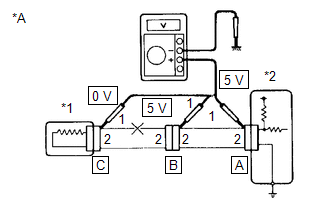
|
*A | Fig. 4 |
|
*1 | SENSOR |
|
*2 | ECU |
(1)
In a circuit in which voltage is applied to the ECU connector terminal,
an open circuit can be checked by conducting a voltage check.
With
each connector still connected, measure the voltage between body ground
and the following terminals (in this order): 1) terminal 1 of connector
A, 2) terminal 1 of connector B, and 3) terminal 1 of connector C.
Standard Voltage (Fig. 4):
|
Tester Connection | Condition |
Specified Condition |
|
Connector A terminal 1 - Body ground |
Ignition switch ON (IG) |
5 V |
| Connector B terminal 1 - Body ground |
Ignition switch ON (IG) |
5 V |
| Connector C terminal 1 - Body ground |
Ignition switch ON (IG) |
Below 1 V |
- If the results match the values specified above, an open circuit exists
in the wire harness between terminal 1 of connector B and terminal 1 of
connector C.
CHECK FOR SHORT CIRCUIT
(a) If a wire in the harness is shorted to ground (Fig. 5), locate the shorted section by measuring the resistance as follows:
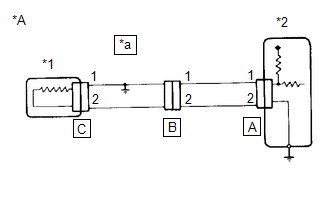
|
*A | Fig. 5 |
|
*1 | SENSOR |
|
*2 | ECU |
|
*a | SHORT |
(b) Check the resistance to body ground.
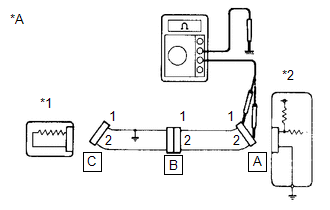
|
*A | Fig. 6 |
|
*1 | SENSOR |
|
*2 | ECU |
(1) Disconnect connectors A and C, and measure the resistance.
Standard Resistance (Fig. 6):
|
Tester Connection | Condition |
Specified Condition |
|
Connector A terminal 1 - Body ground |
Always | Below 1 Ω |
|
Connector A terminal 2 - Body ground |
Always | 10 kΩ or higher |
HINT:
Measure the resistance while lightly shaking the wire harness vertically and horizontally.
- If the results match the values specified above, a short circuit exists
between terminal 1 of connector A and terminal 1 of connector C.
(2) Disconnect connector B and measure the resistance.
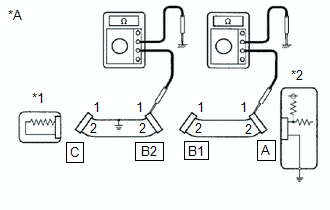
|
*A | Fig. 7 |
|
*1 | SENSOR |
|
*2 | ECU |
Standard Resistance (Fig. 7):
|
Tester Connection | Condition |
Specified Condition |
|
Connector A terminal 1 - Body ground |
Always | 10 kΩ or higher |
|
Connector B2 terminal 1 - Body ground |
Always | Below 1 Ω |
- If the results match the values specified above, a short circuit exists
between terminal 1 of connector B2 and terminal 1 of connector C.
CHECK AND REPLACE ECU
NOTICE:
- The connector should not be disconnected from the ECU. Perform the
inspection from the backside of the connector on the wire harness side.
- When no measuring condition is specified, perform the inspection with the engine stopped and the ignition switch ON (IG).
- Check that the connectors are fully seated. Check for loose, corroded or broken wires.
(a) First, check the ECU ground
circuit. If it is faulty, repair it. If it is normal, the ECU could be
faulty. Temporarily replace the ECU with a known good one and check if
the problem symptoms occur. If the problem symptoms disappear, replace
the original ECU.
(1) Measure the resistance between the ECU ground terminal and body ground.
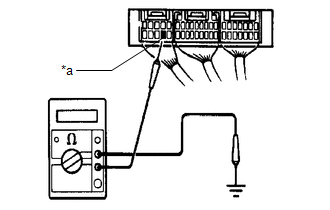
Standard Resistance:
Below 1 Ω
(2)
Disconnect the ECU connector. Check the ground terminals on the ECU
side and wire harness side for bent terminals, corrosion or foreign
matter. Lastly, check the contact pressure of the female terminals.
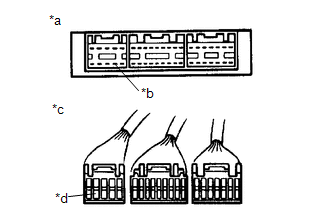
|
*a | Component without harness connected
(ECU) |
| *b |
Ground |
| *c |
Front view of wire harness connector (to ECU) |
|
*d | Ground |
General Information
GENERAL INFORMATION
- A large number of ECU controlled systems are used in this vehicle. In
general, ECU controlled systems are considered to be very intricate,
requiring a high level of technical knowledge to troubleshoot. However,
most problem checking procedures only involve inspecting the ECU
controlled system circuits one by one. An adequate understanding of the
system and a basic knowledge of electricity is enough to perform
effective troubleshooting, accurate diagnosis and necessary repairs.
TROUBLESHOOTING PROCEDURES
- The troubleshooting procedures consist of diagnostic procedures for when
a DTC is stored and diagnostic procedures for when no DTCs are stored.
The basic idea is explained in the following table.
|
Procedure Type |
Details |
Troubleshooting Method |
|
DTC Based Diagnosis |
The diagnostic procedure is based on the DTC that is stored.
|
The malfunctioning part is identified based on the DTC detection conditions using a process of elimination.
The possible trouble areas are eliminated one-by-one using the Techstream and inspection of related parts.
|
|
Symptom Based Diagnosis
(No DTCs stored) |
The diagnostic procedure is based on problem symptoms.
|
The malfunctioning part is identified based on the problem symptoms using a process of elimination.
The possible trouble areas are eliminated one-by-one using the Techstream and inspection of related parts.
|
- Vehicle systems are complex and use many ECUs that are difficult to
inspect independently. Therefore, a process of elimination is used,
where components that can be inspected individually are inspected, and
if no problems are found in these components, the related ECU is
identified as the problem and replaced.
- It is extremely important to ask the customer about the environment and
the conditions present when the problem occurred (Customer Problem
Analysis). This makes it possible to simulate the conditions and confirm
the symptom. If the symptom cannot be confirmed or the DTC does not
recur, the malfunctioning part may not be identified using the
troubleshooting procedure, and the ECU for the related system may be
replaced even though it is not defective. If this happens, the original
problem will not be solved.
- In order to prevent endless expansion of troubleshooting procedures, the
troubleshooting procedures are written with the assumption that
multiple malfunctions do not occur simultaneously for a single problem
symptom.
- To identify the malfunctioning part, troubleshooting procedures narrow
down the target by separating components, ECUs and wire harnesses during
the inspection. If the wire harness is identified as the cause of the
problem, it is necessary to inspect not only the connections to
components and ECUs but also all of the wire harness connectors between
the component and the ECU.
DESCRIPTION
(a)
The data of each system and Diagnostic Trouble Codes (DTCs) can be read
from the Data Link Connector 3 (DLC3) of the vehicle. When the system
seems to be malfunctioning, use the Techstream to check for malfunctions
and perform repairs.
CHECK DLC3
(a)
The vehicle ECUs use ISO 15765-4 communication protocol. The terminal
arrangement of the DLC3 complies with SAE J1962 and matches the ISO
15765-4 format.
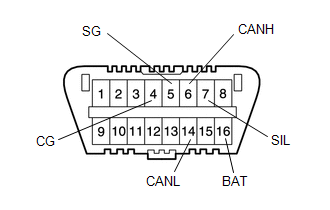
|
Terminal No. (Symbol) | Terminal Description |
Condition | Specified Condition |
|
7 (SIL) - 5 (SG) | Bus "+" line |
During transmission | Pulse generation |
|
4 (CG) - Body ground |
Chassis ground | Always |
Below 1 Ω |
|
5 (SG) - Body ground |
Signal ground | Always |
Below 1 Ω |
|
16 (BAT) - Body ground |
Auxiliary battery positive |
Always | 11 to 14 V |
|
6 (CANH) - 14 (CANL) |
CAN bus line | Ignition switch off* |
54 to 69 Ω |
|
6 (CANH) - 4 (CG) | HIGH-level CAN bus line |
Ignition switch off* |
200 Ω or higher |
|
14 (CANL) - 4 (CG) | LOW-level CAN bus line |
Ignition switch off* |
200 Ω or higher |
|
6 (CANH) - 16 (BAT) | HIGH-level CAN bus line |
Ignition switch off* |
6 kΩ or higher |
|
14 (CANL) - 16 (BAT) |
LOW-level CAN bus line |
Ignition switch off* |
6 kΩ or higher |
NOTICE:
*:
Before measuring the resistance, leave the vehicle as is for at least 1
minute and do not operate the ignition switch, any other switches or
the doors.
If the result is not as specified, the DLC3 may be malfunctioning. Repair or replace the harness or connector.
How To Proceed With Troubleshooting
HOW TO PROCEED WITH TROUBLESHOOTING
OPERATION FLOW
HINT:
Perform
troubleshooting in accordance with the procedure below. The following
is an outline of basic troubleshooting procedure. Confirm the
troubleshooting procedure for the circuit you are working on before
beginning troubleshooting.
1.VEHICLE BROUGHT TO WORKSHOP
2.CUSTOMER PROBLEM ANALYSIS
(a) Ask the customer about the conditions and environment when the problem occurred.
3.INSPECT AUXILIARY BATTERY VOLTAGE
(a) Measure the auxiliary battery voltage.
Standard Voltage:
11 to 14 V
If the voltage is below 11 V, recharge or replace the auxiliary battery before proceeding to the next step.
4.SYMPTOM CONFIRMATION AND DTC (AND FREEZE FRAME DATA) CHECK
(a) Visually check the wire harnesses, connectors and fuses for open and short circuits.
(b) Warm up the engine to the normal operating temperature.
(c) Confirm the problem symptoms and conditions, and check for DTCs.
|
Result | Proceed to |
|
DTCs are output | Go to step 5 |
|
DTCs are not output | Go to step 6 |
5.DTC CHART
(a)
Find the output DTC in the DTC chart. Look at the Trouble Area column
for a list of potentially malfunctioning circuits and/or parts.
6.PROBLEM SYMPTOMS CHART
(a)
Find the problem symptoms in the problem symptoms table. Look at the
Suspected Area column for a list of potentially malfunctioning circuits
and/or parts.
7.CIRCUIT INSPECTION OR PARTS INSPECTION
(a) Identify the malfunctioning circuit or part.
8.ADJUST, REPAIR OR REPLACE
(a) Adjust, repair or replace the malfunctioning circuit or parts.
9.CONFIRMATION TEST
(a)
After the adjustment, repairs or replacement of components, confirm
that the malfunction no longer exists. If the malfunction does not
recur, perform a confirmation test under the same conditions and in the
same environment as when the malfunction first occurred.
(b) END
CUSTOMER PROBLEM ANALYSIS
HINT:
- When troubleshooting, confirm that the problem symptoms have been
accurately identified. Preconceptions should be discarded in order to
make an accurate judgment. To clearly understand what the problem
symptoms are, it is extremely important to ask the customer about the
problem and the conditions at the time the malfunction occurred.
- Gather as much information as possible for reference. Past problems that seem unrelated may also help in some cases.
- The following 5 items are important points for problem analysis:
|
What |
Vehicle model, system name |
|
When |
Date, time, occurrence frequency |
|
Where |
Road conditions |
|
Under what conditions? |
Driving conditions, weather conditions |
|
How did it happen? |
Problem symptoms |
SYMPTOM CONFIRMATION AND DIAGNOSTIC TROUBLE CODE
HINT:
The diagnostic system in this vehicle has various functions.
- The first function is the Diagnostic Trouble Code (DTC) check. A DTC is a
code stored in the ECU memory whenever a malfunction in the signal
circuits to the ECU occurs. In a DTC check, DTCs stored by a previous
malfunction can be checked by a technician during troubleshooting.
- In the DTC check, it is very important to determine whether the problem
indicated by a DTC either: 1) still exists, or 2) occurred in the past
but the vehicle has returned to normal. In addition, the DTC should be
compared to any customer reported problem symptoms to see if they are
related. For this reason, DTCs should be checked before and after
confirmation of symptoms (i.e., whether or not problem symptoms exist)
to determine current system conditions, as shown below.
- Never skip the DTC check. Failing to check for DTCs, depending on the
case, may result in unnecessary troubleshooting for systems operating
normally or lead to repairs not related to the problem. Follow the
procedure listed below in the correct order.
- The following shows how to proceed with troubleshooting using the DTC
check and will indicate how to proceed either to DTC troubleshooting or
to the troubleshooting of each problem symptom.
1.DTC CHECK
2.MAKE A NOTE OF DTC DISPLAYED AND THEN CLEAR DTCs
3.SYMPTOM CONFIRMATION
|
Result | Proceed to |
|
No symptoms exist | Go to step 4 |
|
Symptoms exist | Go to step 5 |
4.SIMULATION TEST USING SYMPTOM SIMULATION METHODS
5.DTC CHECK
|
Result | Proceed to |
|
DTCs are not output | Go to step 6 |
|
DTCs are output | TROUBLESHOOT FOR PROBLEM INDICATED BY DTC |
6.SYMPTOM CONFIRMATION
|
Result | Proceed to |
|
Symptoms exist | TROUBLESHOOT FOR EACH PROBLEM SYMPTOM |
|
No symptoms exist | END |
If
a DTC was displayed in the initial DTC check, the problem may have
occurred in a wire harness or connector in that circuit in the past.
Check the wire harness and connectors.
If
problem symptoms are present, but no DTCs were stored again after they
were cleared, then the problem causing the symptom may be occurring for
something that does not store DTCs (the DTC that was displayed in the
initial DTC check may have been from a past problem or a secondary
problem).
SYMPTOM SIMULATION
HINT:
The
most difficult case in troubleshooting is when no problem symptoms
occur. In such a case, a thorough problem analysis must be carried out. A
simulation of the same or similar conditions and environment in which
the problem occurred in the customer's vehicle should be carried out. No
matter how much skill or experience a technician has, troubleshooting
without confirming the problem symptoms will lead to important repairs
being overlooked and mistakes or delays.
For example:
With
a problem that only occurs when the engine is cold or as a result of
vibration caused by the road during driving, the problem can never be
determined if the symptoms are being checked on a stationary vehicle or a
vehicle with a warmed-up engine. Vibration, heat or water penetration
(moisture) is difficult to reproduce. The following symptom simulation
tests are effective substitutes for the conditions and can be applied to
a stationary vehicle. Important points in the symptom simulation test:
In
the symptom simulation test, the problem symptoms as well as the
problem area or parts must be confirmed. First, narrow down the possible
problem circuits according to the symptoms. Then, connect the
electrical tester and carry out the symptom simulation test, judging
whether the circuit being tested is defective or normal. Also, confirm
the problem symptoms at the same time. Refer to Problem Symptoms Table
for each system to narrow down the possible causes.
To reproduce DTCs, it is necessary to satisfy the respective DTC detection conditions.
(a) VIBRATION METHOD: When a malfunction seems to occur as a result of vibration.
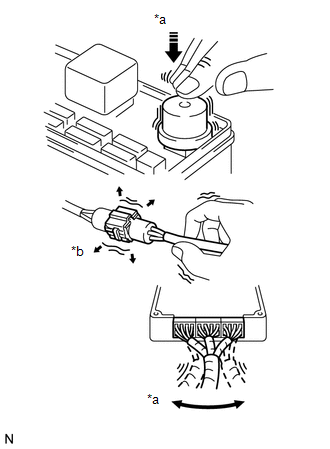
|
*a | Vibrate Slightly |
|
*b | Shake Slightly |
(1) PARTS OR SENSORS
Apply
slight vibration with a finger to the part or sensor suspected to be
the cause of the problem, and check whether the malfunction occurs.
NOTICE:
Applying strong vibration to relays may open the relays.
(2) CONNECTORS
Slightly shake the connector vertically and horizontally.
(3) WIRE HARNESS
Slightly shake the wire harness vertically and horizontally.
HINT:
The connector joint and fulcrum of the vibration are the major areas that should be checked thoroughly.
(b) HEAT METHOD: When a malfunction seems to occur when the area in question is heated.
(1)
Heat the component that is the possible cause of the malfunction with a
hair dryer or similar device. Check if the malfunction occurs.
NOTICE:
- Do not heat components to more than 60°C (140°F). Exceeding this temperature may damage the components.
- Do not apply heat directly to parts in an ECU.
(c) WATER SPRINKLING METHOD: When a malfunction seems to occur on a rainy day or in high-humidity.

(1) Sprinkle water onto the vehicle and check if the malfunction occurs.
NOTICE:
- Never sprinkle water directly into the engine compartment. Indirectly
change the temperature and humidity by spraying water onto the front of
the radiator.
- Never apply water directly onto the electronic components.
HINT:
If the
vehicle has or had a water leak problem, the leak may have damaged the
ECU or connections. Look for evidence of corrosion or short circuits.
Proceed with caution during water tests.
(d) HIGH ELECTRICAL LOAD METHOD: When a malfunction seems to occur when the electrical load is high.

(1) Turn on the heater blower, headlights, rear window defogger and all other electrical loads. Check if the malfunction recurs.
DIAGNOSTIC TROUBLE CODE CHART
Look
for output Diagnostic Trouble Codes (DTCs) (from the DTC checks) in the
Diagnostic Trouble Code chart of the appropriate section. Use the chart
to determine the trouble area and the proper inspection procedure. A
description of each of the columns of the chart is shown in the table
below.
|
Item | Description |
|
DTC No. | Indicates the diagnostic trouble code. |
|
Detection Item | Indicates the system or details of the problem. |
|
DTC Detection Condition | Indicates the condition in which a DTC is stored. |
|
Trouble Area | Indicates the suspected areas of the problem. |
|
Link | Indicates the page where the inspection procedure for each circuit is to be found, or gives instruction for checking and repair. |
PROBLEM SYMPTOMS TABLE
When
no DTCs are output but the problem still occurs, use the Problem
Symptoms Table. The suspected areas (circuits or parts) for each problem
symptom are shown in the table. The suspected areas are listed in order
of probability. A description of each of the table columns is shown in
the following table.
HINT:
In
some cases, the problem is not detected by the diagnostic system even
though a problem symptom occurs. It is possible that the problem occurs
outside the detection range of the diagnostic system, or that the
problem occurs in a completely different system.
|
Item | Description |
|
Symptom | - |
|
Suspected Area | Indicates the circuit or part which needs to be checked. |
|
Link | Indicates the page where the inspection procedure is located. |
INSPECTION
A description of the main points for inspection of suspected areas is shown in the following table.
|
Item | Description |
|
Description | Explains the major role and operation of the circuit or system and its component parts. |
|
DTC No., DTC Detection Condition and Trouble Area |
Indicates the diagnostic trouble codes, DTC detection conditions and suspected areas for a problem. |
|
Wiring Diagram | Indicates a wiring diagram for the circuit or system.
This diagram can be used together with the Electrical Wiring Diagram to thoroughly understand the circuit.
Wire
colors are indicated by alphabetical codes. B = Black, L = Blue, R =
Red, BR = Brown, LG = Light Green, V = Violet, G = Green, O = Orange, W =
White, GR = Gray, P = Pink, Y = Yellow, SB = Sky Blue The first letter indicates the basic wire color and the second letter indicates the color of the stripe. |
|
Procedure | Shows
the procedure not only to determine whether the circuit is normal or
abnormal, but also to determine whether the problem is located in the
sensors, actuators, wire harness or ECU. |
|
Illustration of the ECU connector during the check |
Shows whether the connector being checked is connected or disconnected.
The connections for an electrical tester are indicated by (+) or (-) after the terminal name.
For inspections between a connector and body ground, information about the ground is not shown in the illustration. |

















